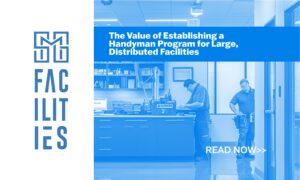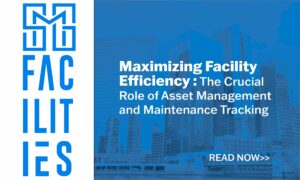When most of us flip a switch, we usually fail to think about the massive amount of scientific development and engineering that went into fulfilling that ancient command: Let there be light. What the ancients would have considered magic – lighting up a store or warehouse for the day — we think of as a typical Tuesday morning.
Yet it’s not that simple. From the power companies that generate the electricity to the grids through which it flows to the lines that bring it to your door, a vast amount of technology goes into delivering power to you. Similarly, operations within the building rely on networks and hardware of systems working seamlessly together. The same goes for plumbing, HVAC systems, construction management, remodeling and upgrades, painting, engineering, exterior maintenance … the list goes on and on. Each of these workflows is composed of thousands of moving parts and people.
Unfortunately, that means most systems are not as efficient as they could be – often by a long shot. Facilities management is littered with waste and misallocation of resources, usually through no fault of the dedicated facility managers, who are often overwhelmed and overworked. Without the ability to collect, manipulate, and use facilities management data analytics, they’re hamstrung by a lack of knowledge.
Say Goodbye to Antiquated Processes
The truth is facilities management as an industry has been a collective Luddite for decades. In many areas, the industry has lagged behind others in its reluctance to implement tech-forward, growth-minded solutions. Why? Because it’s purely reactive, with facility managers only ever “keeping up,” rather than have the authority and the power to innovate. Most have difficulty finding reliable service provides and often get stymied when they try to scale across a extensive portfolio.
However, that’s quickly changing as more multi-site businesses turn toward scalable analytics in facilities management. With data-driven facility management approaches, businesses and facility professionals can gain unprecedented insight into operations and the distribute assets which when efficiently maintained contribute to the health and well-being of the team member and guest – not to mention contribute to the company’s overal brand image.
If you’re curious about data-driven management, we’ve got you covered. Today, we’ll talk about what it is, ways to harness data analytics in facilities management, and how to get started. Let’s dive in.
What is Data-Driven Facility Management?
While the name might be a mouthful, data-driven facility management is nothing more than using “actionable” data to optimize facilities management operations. In so doing, you gain the ability to transition from the chaos of reactive processes to proactive management by using clear, concise, and actionable information regarding:
- Where you’re maintenance “dollar” is going
- The operational efficiency of critical assets across a distributed portfolio
- How historical maintenance history impacts your future “spend”
- How proactive maintenance practices impacts bottom line
- How deferred maintenance detracts from operational efficiency of critical equipment
- Whether “actionable” data is accessible, streamlined, and accurate
“Actionable” data gives you the power to reduce waste, maximize efficiency, improve your partnerships, gain transparency, improve asset management, and get smarter about repairs and maintenance. With this information, you can improve the experience of people who work or shop in your stores while saving money and the planet. And all it takes is a little planning. Pretty good deal, right? If you don’t put intentional strategies in place, you’ll never reap these rewards.
5 Ways Multi-Site Businesses Can Harness the Power of Data Driven Facility Management
All right, so you’re sold on data analytics in facilities management … but how do you do it? Yes, you’ve got lots of data at your fingertips. But are you using the correct figures? Are you analyzing them using the right algorithms? Are you applying your new knowledge in the right places? If you’re asking these questions, you’re already ahead of the game. Accordingly, here are five ways businesses can immediately put data-driven management to work.
1. Find the Right Partner, Every Time
It can be challenging to find reliable partners, yet not doing so can result in losses and inefficiencies. When you have so many processes to track, it’s easy for waste to slip through the cracks unnoticed. Similarly, it’s easy to get bogged down by duplicate requests, confusing ticketing, inaccurate estimates, and a lack of visibility into assets and their needs.
If you can track what’s happening in your facilities by trade, it’s much easier to see where your money is going. Ditto, you will have an easier time getting jobs done.
You need a process that allows you to set preferences when looking for service providers and filter your options by geographic areas, preferences, and scope of work. By carefully monitoring jobs and providers, you can determine whom you like working with while enforcing rules and regulations, so you’re always above board.
2. Improve Value with Visibility
Traditional facilities management sees facility managers (FMs) struggling to keep up with issues and spending on band-aid solutions instead of solving the problem. They end up:
- Lacking the resources to compare spending on repairs versus replacements
- Replacing assets when they could have repaired them
- Fixing things as they come up rather than taking a proactive approach
- Juggling invoices and work orders without a sense of hierarchical order
- Only seeing where the budget is going afterward, rather than in real-time
A bird’s eye view will give visibility into the above sectors, allowing you to address these concerns and quit wasting money. Now you can develop holistic strategies that apply to every facility and stop scrambling to keep up with what’s happening at this one or that.
3. Optimize Invoice and Approval Processes
The invoice and approval process alone can bury FMs under a mountain of paperwork (not to mention anxiety and depression). When you’re too stressed to get to everything in a day, the cumulative effects of this quickly become overwhelming. Yet too many businesses are still stuck in an obsolete – often manual – workflow that requires constant document juggling, sifting through cluttered emails, and relying on manual invoicing and approval processes. That’s no way to live — certainly not when you’re responsible for operations at multiple facilities.
Electronic invoicing submittal and coding will help you align costs with work orders, give your service providers an easy electronic solution for filling out invoices and attaching documentation and let go of the tired job of annual coding. In the same vein, you should streamline your approvals with automated processes, standardization, security, and collaborative workflows — all while creating a functional paperless “paper” trail.
4. Maximize Efficiency in Maintenance
Traditional facilities management sees managers struggling to keep up with maintenance, which keeps them from getting ahead of busy operations. Soon enough, you’re like Alice in Through the Looking Glass, running as fast as possible just to stay in the same place.
If only there were some way to stay on top of assets and prevent their premature wear and breakdown … oh, wait! There is, and it’s scheduled maintenance. With systems that provide incisive insight into the status of all assets, you can set up recurring maintenance visits with the right vendors to extend their shelf life, protect their components, and minimize disruption and downtime. This also reduces costs and improves efficiency at your facilities, so your time can be spent on tasks that widen the profit margin rather than putting out fires.
5. Streamline Operations Through a Single-Source
When you have to juggle multiple platforms in facilities management and extract different info from different sources, it is literally impossible to understand what’s going on. It’s a Herculean task that even Einstein couldn’t have completed (pardon the mixed metaphors).
It’s time to streamline your operations with smart platform that can integrate your assets into a single source of truth. This provides FMs with unprecedented access to unprecedented assets. With the suitable systems at your fingertips, contained within a single dashboard accessible to all stakeholders, you can:
- Simply all facilities maintenance processes
- Track requests and progress
- Update everyone on a real-time basis
Yes, it’s just as good as it sounds. And yes, that can become your story.
The Future of Facilities Management is Data-Driven
No one would disagree that human learning improves decision-making and efficiency. It’s no different with machines, which use artificial intelligence to gain insight from their daily workflows and processes, then apply that insight for better decision-making the next time.
Data analytics in facilities management relies heavily on the judicious use of technologies, as well as sourcing the right vendors, creating transparency, optimizing invoices, maximizing efficiency, and streamlining operations. SMG Facilities is here to help with them all.
Our integrated facilities management company was designed with the express purpose of driving profit improvement through better facilities management. We always maintain a client-first philosophy, whether you’re interested in getting help with interior upkeep, handyman services, grounds management, plumbing and electrical, or any other maintenance.
With smart, machine learning-powered, data-driven management, we provide you with single-source accountability for any facilities maintenance service. This trims your task list, boosts your profits, and makes your job easier overall. Now you can extend assets, streamline workflows, and provide a pleasanter experience for customers and employees – all with minimal disruption to your facilities.
Ready to learn more about facilities management data analytics? We’re ready too. We can take complete control of the processes involved so you can pay attention to your areas of core competence. Or, if you prefer, we can partner with existing teams to bring them the insight and management capabilities to improve their operations.
Either way, you get to look forward to tangible outcomes that protect the bottom line. Ready to learn more about your options? Contact SMG today.





